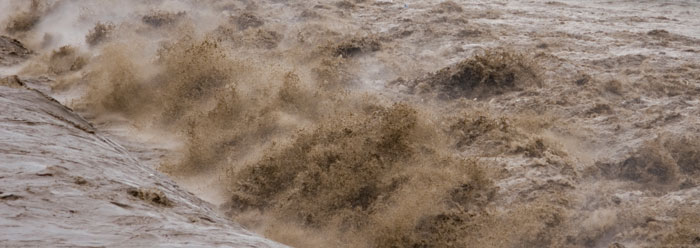On October 26, strategically placed explosives breached the Condit Dam in Washington state in order to reopen the White Salmon River to salmon and other aquatic animals.
Upon detonation, the lake immediately began draining, but a video posted on a National Geographic website clearly showed that instead of clear water, fast-moving mud emerged from the torrent below the damaged dam.1 The time-lapse video also showed loads of silt sinking, settling, and flowing away with the dark fluid.
Given the small-scale nature of this event, what effects might a much larger torrent have?
The muddy water from this controlled dam breach resembled, though to a lesser degree, the more catastrophic mudflow that resulted from the uncontrolled 1982 breach of the Lawn Lake dam, which spilled debris and transported truck-size boulders into Colorado's Fall River.2 It deposited layers of mud and sorted sediment in flatter downstream areas. Eyewitnesses said that the front of the flood resembled a lumbering wall of mud that produced a terrible, thunderous roar.
If these local flood events, both controlled and uncontrolled, did this much damage, imagine what the earth's surface endured when the Flood of Noah's day completely covered it. Enormous sheets of mud and sediment would have scoured the surface. When the momentum decreased, the sediment load would have dropped out. Multiple massive, transgressive, and regressive mud-transporting phases would have formed layered deposits over the course of a year—the time specified by the Genesis record.
The 1980 eruption of Mount St. Helens showed that the earth itself can produce muddy catastrophes greater than man-made floods. Fast-moving mudflows caused more damage than any other aspect of the volcanic explosion.3
How could Noah's Flood have buried countless creatures in sediments that later dried and hardened into fossiliferous sandstone and mudstone? First, as the Condit Dam breach showed, fast-moving water becomes fast-moving mud. Second, a worldwide flood would leave behind worldwide sediments. Today, continent-size and trans-continent-extensive sedimentary layers stand as monuments to the mud transported and deposited by the Genesis Flood.4
References
- Howard, B. C. Spectacular Time-Lapse Video of Historic Dam Removal. National Geographic Daily News. Posted on news.nationalgeographic.com October 28, 2011, accessed October 31, 2011.
- The Lawn Lake Flood. Town of Estes Park, Colorado fact sheet. Posted on estesnet.com, accessed November 1, 2011.
- Morris, J. and S. A. Austin. 2003. Footprints in the Ash. Green River, AR: Master Books, 46.
- Snelling, A. A. 2008. Sand Transported Cross Country. Answers. 3 (4): 96-99.
* Mr. Thomas is Science Writer at the Institute for Creation Research.
Article posted on November 9, 2011.

























